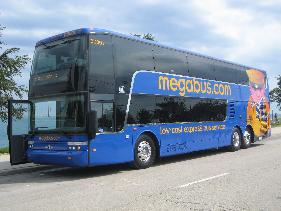

Switching gears for success
Tom Krekel //April 4, 2012//
 This is the story of a company that lived in an industry in decline. The industry: intercity bus travel. The number of riders dropped from 140 million in 1960 to 40 million in 1990 according to the U.S. Government Accountability office. That’s the same year Greyhound filed for bankruptcy. Then it got worst.
This is the story of a company that lived in an industry in decline. The industry: intercity bus travel. The number of riders dropped from 140 million in 1960 to 40 million in 1990 according to the U.S. Government Accountability office. That’s the same year Greyhound filed for bankruptcy. Then it got worst.
Bus transportation was at one time seen as glamorous. Some may recall the prime time television commercials for Greyhound during TV’s Bonanza? “Go Greyhound…and leave the driving to us.” In the ‘50’s and ’60’s, bus travel was the way many Americans went off to college or came home from service. Through the ’70’s and ’80’s bus travel developed a second-class stigma.
Today to drive or fly a 200-500 mile trip is a close call. This is especially true when you’re traveling to a non-major airport town. Generally flying is faster until you add in the time to the airport, and the time in security lines. On the other hand, $3.50 per gallon and the 4-7 hour drive isn’t a cheery alternative.
Here’s what a bus company called Megabus asked themselves: What if you did away with the bus depot? What if you picked people up on the street corner? Maybe you could sell tickets on the web? How about creating a little buzz by selling the first fare on each route for $1? Instead of advertising let’s try colorful graphically painted buses.
And then they thought, “Let’s put free WIFI onboard so that our passengers be productive while they’re traveling.”
Megabus specializes in connecting major metro markets with surrounding towns in a 400 mile or so radius.
How’s it working out? In 2010 they added Washington, D.C and Philadelphia as hubs. That year they did $100 million in business, while they hired 270 new employees. Ninety percent of their customers buy their tickets online, usually having the ticket sent to a smart phone. They’ve been able to attract new customer segments back to the bus: 18-34 year olds, many of whom are well educated, and unaccompanied women. Their overhead costs have been permanently reduced with reduced back office staffing and no depots to man.
Like an algebra solution that seems simple once you see its answer, the strategies used by Megabus appear obvious. What if the way forward isn’t obvious?
In their book Business Model Generation, Alexander Osterwalder & Yves Pigneur describe a process to explore your enterprise’s business model. Their nine business model components can give you and your leadership team a language in which to have a more focused brain-storming session about what might be.
- Customer Segments
- Value Propositions
- Channels
- Customer Relationships
- Revenue Streams
- Key Resources
- Key Activities
- Key Partnerships
- Cost Structure
The first step is describing your model in terms of these nine areas, as it is today. Then the fun begins. What could it be? Let’s apply the Megabus example to three of these building blocks.
Megabus Customer Segments
Who is under-served? With Megabus, it was unaccompanied women for one. People looking to get somewhere too far to drive and to close to fly given the new travel environment, for another.
Megabus’ Value Propositions
For Megabus it was changing their model to now deliver new benefits not previously offered. Like these:
- Personal productivity (four to six hours with WIFI)
- Access to towns too close to fly and too far to drive.
- Ease of ticketing and low fares with the first one at $1.
- Safety and convenience of pickup on busy street corners.
- Simple access to ticketing over the web.
Megabus Cost Structure
- 90 percent booking online means reduced back-office staff. No tickets to print.
- No terminal/depot costs.
- Lower advertising expenditures
Often our conception of “what is possible” is anchored in what we know…..in what has always been. New opportunities will always be present. CEOs who have exhausted cost cutting options need to focus on how their business model can be altered in order to find new top-line growth.
























